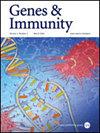GXYLT2:透明细胞肾细胞癌抗pd -1疗效的新兴治疗靶点和预测性生物标志物
IF 4.5
3区 医学
Q1 GENETICS & HEREDITY
引用次数: 0
摘要
有研究报道,葡萄糖苷木糖基转移酶2 (GXYLT2)在促进肿瘤进展中起作用,但其在透明细胞肾细胞癌(ccRCC)中的作用尚不清楚。本研究采用RT-qPCR和western blotting检测GXYLT2的表达水平。采用RNA干扰法敲除GXYLT2。利用CCK-8、伤口愈合实验、克隆形成实验和Transwell实验来研究GXYLT2的功能。通过生物信息学分析探讨肿瘤微环境及其潜在的生物学机制。我们发现GXYLT2在ccRCC中的表达水平高于相邻正常肾组织。GXYLT2高表达的患者临床预后较差。GXYLT2基因敲低可抑制ccRCC细胞的增殖、侵袭、迁移和克隆形成能力。富集分析发现GXYLT2参与Wnt、细胞周期和肌动蛋白细胞骨架调控信号通路。在接受抗pd -1治疗后,GXYLT2高表达的患者比GXYLT2低表达的患者有更长的无进展生存期。总之,GXYLT2是ccRCC的一个新的潜在治疗靶点。同时,GXYLT2可作为预测免疫治疗反应的新标志物。本文章由计算机程序翻译,如有差异,请以英文原文为准。

GXYLT2: an emerging therapeutic target and predictive biomarker for anti-PD-1 efficacy in clear cell renal cell carcinoma
There are studies reporting that glucoside xylosyltransferase 2 (GXYLT2) has a role in promoting tumor progression, but its role in clear cell renal cell carcinoma (ccRCC) remains unclear. In this study, RT-qPCR and western blotting were employed to detect the expression level of GXYLT2. RNA interference assays were used to knock down GXYLT2. CCK-8, wound healing assays, clone formation assays, and Transwell assays were utilized to investigate the function of GXYLT2. Bioinformatics analysis was used to explore the tumor microenvironment and potential biological mechanisms. We found that the expression level of GXYLT2 in ccRCC was higher than that in adjacent normal renal tissues. Patients with high GXYLT2 expression have worse clinical outcomes. Knockdown of GXYLT2 inhibits the proliferation, invasion, migration, and clone formation ability of ccRCC cells. Enrichment analysis uncovered that GXYLT2 participates in Wnt, cell cycle, and actin cytoskeleton regulation signaling pathways. After receiving anti-PD-1 therapy, patients with high GXYLT2 expression had longer progression-free survival compared with those with low GXYLT2 expression. In conclusion, GXYLT2 is a novel potential therapeutic target for ccRCC. Meanwhile, GXYLT2 can be used as a novel marker for predicting immunotherapeutic response.
求助全文
通过发布文献求助,成功后即可免费获取论文全文。
去求助
来源期刊

Genes and immunity
医学-免疫学
CiteScore
8.90
自引率
4.00%
发文量
28
审稿时长
6-12 weeks
期刊介绍:
Genes & Immunity emphasizes studies investigating how genetic, genomic and functional variations affect immune cells and the immune system, and associated processes in the regulation of health and disease. It further highlights articles on the transcriptional and posttranslational control of gene products involved in signaling pathways regulating immune cells, and protective and destructive immune responses.
 求助内容:
求助内容: 应助结果提醒方式:
应助结果提醒方式:


